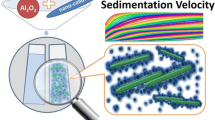Abstract
Hybrid dispersion systems based on cellulose nanocrystals (CNC) and aluminum oxide have been prepared, and the influence of the ζ-potential on their stability has been studied for a wide range of the concentration ratio of the components. Their influence on the morphology and properties of the hybrid particles is evaluated. It is established that one can obtain stable colloidal dispersions with both negatively and positively charged particles or hybrid systems with a neutralized surface charge by controlling the surface potential.
Similar content being viewed by others
References
Pomogailo, A.D. and Dzhardimalieva, G.I., Nanostructured Materials Preparation via Condensation Ways, Amsterdam: Springer, 2014.
Shchipunov, Y.A. and Karpenko, T.Y., Hybrid polysaccharide–silica nanocomposites prepared by the sol–gel technique, Langmuir, 2004, vol. 20, no. 10, pp. 3882–3887.
Sevostyanov, M.A., Fedotov, A.Yu., Kolmakov, A.G., Zabolotnyi, V.T., Barinov, S.M., Goncharenko, B.A., Komlev, V.S., Baikin, A.S., Sergienko, K.V., Teterina, A.Yu., Nasakina, E.O., Leonova, Yu.O., and Leonov, A.V., Mechanical properties of nanostructured nitinol/chitosan composite material, Inorg. Mater.: Appl. Res., 2014, vol. 5, no. 4, pp. 344–346.
Kononova, S.V., Korytkova, E.N., Maslennikova, T.P., Romashkova, K.A., Kruchinina, E.V., Potokin, I.L., and Gusarov, V.V., Polymer-inorganic nanocomposites based on aromatic polyamidoimides effective in the processes of liquids separation, Russ. J. Gen. Chem., 2010, vol. 80, no. 6, pp. 1136–1142.
Zhou, Z., Lu, C., Wu, X., and Zhang, X., Cellulose nanocrystals as a novel support for CuO nanoparticles catalysts: Facile synthesis and their application to 4-nitrophenol reduction, RSC Adv., 2013, vol. 3, no. 48, pp. 26066–26073.
Lin, N. and Dufresne, A., Nanocellulose in biomedicine: Current status and future prospect, Eur. Polym. J., 2014, vol. 59, pp. 302–325.
Romanov, D.P., Baklagina, Yu.G., Gubanova, G.N., Ugolkov, V.L., Lavrent’ev, V.K., Tkachenko, A.A., Sinyaev, V.A., Sukhanova, T.E., and Khripunov, A.K., Formation of organic-inorganic composite materials based on cellulose Acetobacter xylinum and calcium phosphates for medical applications, Glass Phys. Chem., 2010, vol. 36, no. 4, pp. 484–493.
Salas, C., Nypelo, T., Rodriguez-Abreu, C., Carrillo, C., and Rojas, O.J., Nanocellulose properties and applications in colloids and interfaces, Curr. Opin. Colloid Interface Sci., 2014, vol. 19, no. 5, pp. 383–396.
Wei, H., Rodriguez, K., Renneckar, S., and Vikesland, P.J., Environmental science and engineering applications of nanocellulose-based nanocomposites, Environ. Sci.: Nano, 2014, vol. 1, no. 4, pp. 302–316.
Han, J., Zhou, C., Wu, Y., Liu, F., and Wu, Q., Selfassembling behavior of cellulose nanoparticles during freeze-drying: effect of suspension concentration, particle size, crystal structure, and surface charge, Biomacromolecules, 2013, vol. 14, no. 5, pp. 1529–1540.
Liu, S., Tao, D., Bai, H., and Liu, X., Cellulosenanowhisker-templated synthesis of titanium dioxide/cellulose nanomaterials with promising photocatalytic abilities, J. Appl. Polym. Sci., 2012, vol. 126, no. 1 (Suppl.), pp. E282–E290.
Fu, G., He, A., Jin, Y., Cheng, Q., and Song, J., Fabrication of hollow silica nanorods using nanocrystalline cellulose as templates, BioResources, 2012, vol. 7, no. 2, pp. 2319–2329.
Mautner, A., Lee, K.Y., Tammelin, T., Mathew, A.P., Nedoma, A.J., Li, K., and Bismarck, A., Cellulose nanopapers as tight aqueous ultra-filtration membranes, React. Funct. Polym., 2015, vol. 86, pp. 209–214.
Sitnikov, P.A., Belykh, A.G., Fedoseev, M.S., Vaseneva, I.N., and Kuchin, A.V., Modification of epoxyanhydride polymers with aluminum oxide, Russ. J. Appl. Chem., 2008, vol. 81, no. 5, pp. 826–829.
De Salvi, D.T., Barud, H.S., Caiut, J.M.A., Messaddeq, Y., and Ribeiro, S.J., Self-supported bacterial cellulose/ boehmite organic-inorganic hybrid films, J. Sol–Gel Sci. Technol., 2012, vol. 63, no. 2, pp. 211–218.
Fraschini, C. and Chauve, G., Le Berre, J.F., Ellis, S., Methot, M., O’Connor, B., and Bouchard, J., Critical discussion of light scattering and microscopy techniques for CNC particle sizing, Nord. Pulp Pap. Res. J., 2014, vol. 29, no. 1, pp. 31–40.
Alves, L., Medronho, B., Antunes, F.E., Fernández-García, M.P., Ventura, J., Araújo, J.P., Romano, A., and Lindmand, B., Unusual extraction and characterization of nanocrystalline cellulose from cellulose derivatives, J. Mol. Liq., 2015, vol. 210, pp. 106–112.
Yoldas, B.E., Alumina sol preparation from alkoxides, Am. Ceram. Soc. Bull., 1987, vol. 54, pp. 289–290.
Hogg, R., Healy, T.W., and Furstenau, D.W., Trans. Faraday Soc., 1966, vol. 62, pp. 1638–1651.
Golikova, E.V., Burdina, N.M., and Vysokovskaya, N.A., Aggregation stability of SiO2, FeOOH, ZrO2, CeO2, and natural diamond sols and their binary mixtures: 2. The photometric study of heterocoagulation of SiO2–FeOOH, SiO2–ZrO2, SiO2–CeO2, and CeO2–natural diamond binary systems in KCl solutions, Colloid J., 2002, vol. 64, no. 2, pp. 142–148.
Particle Deposition and Aggregation Measurement, Modelling and Simulation, Elimelech, M., Gregory, J., Jia, X., and Williams, R.A., Eds., Heinemann: Elsevier, 1995.
Lu, S., Pugh, R.J., and Forssberg, E., Interfacial Separation of Particles, Studies in Interface Science, Amsterdam: Elsevier, 2005, vol.20.
Baturenko, D.Yu., Chernoberezhskii, Yu.M., Lorentsson, A.V., and Zhukov, A.N., Effect of pH on the aggregation stability of microcrystalline cellulose dispersions in aqueous 0.1 M NaCl solutions, Colloid J., 2003, vol. 65, no. 6, pp. 666–671.
Krivoshapkin, P.V., Krivoshapkina, E.F., and Dudkin, B.N., Evaluation of surface forces and structure formation in water-organic dispersed systems of aluminum oxide, Glass Phys. Chem., 2012, vol. 38, no. 5, pp. 449–454.
Golikova, E.V., Molodkina, L.M., Zagorskaya, L.L., and Garibin, E.A., Short-range and long-range aggregation of particles in the γ-Al2O3 sol: II. Photometric and ultramicroscopic investigation of the aggregate stability of the positively charged γ-Al2O3 sol, Glass Phys. Chem., 2010, vol. 36, no. 5, pp. 598–608.
Cerbelaud, M., Videcoq, A., Abelard, P., Pagnoux, C., Rossignol, F., and Ferrando, R., Heteroaggregation between Al2O3 Submicrometer Particles and SiO2 nanoparticles: experiment and simulation, Langmuir, 2008, vol. 24, pp. 3001–3008.
Author information
Authors and Affiliations
Corresponding author
Additional information
Original Russian Text © I.S. Martakov, P.V. Krivoshapkin, M.A. Torlopov, V.I. Mikhailov, E.F. Krivoshapkina, 2016, published in Fizika i Khimiya Stekla.
Rights and permissions
About this article
Cite this article
Martakov, I.S., Krivoshapkin, P.V., Torlopov, M.A. et al. Study on the stability of hybrid dispersions of cellulose nanocrystals and aluminum oxide. Glass Phys Chem 42, 590–596 (2016). https://doi.org/10.1134/S1087659616060122
Received:
Published:
Issue Date:
DOI: https://doi.org/10.1134/S1087659616060122




